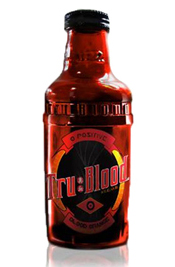
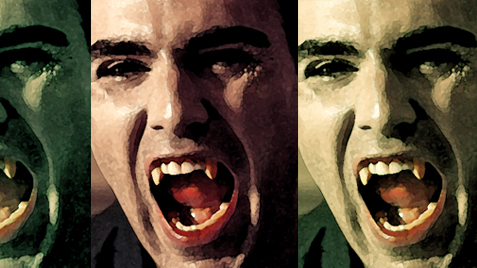
With The Twilight Saga: Breaking Dawn - Part 1 leading the box office since its November release on movie screens across North America, stories about vampires and their relationships with humans have captivated the popular imagination. But there’s a new twist to the story: the vampires currently on the big screen and in several popular television series are bloodsucking creatures of the digital age.
/ Published December 6, 2011
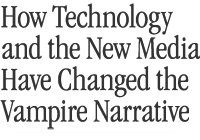
Can the idea of the traditional vampire survive as a modern creature in the digital age? Absolutely, says Alexandra Keller, associate professor of film studies. After all, vampires today have iPods, blogs, Facebook pages and they text.
Intrigued by representations of vampires and what she calls the “digital vampire” and a longtime fan of the TV series “Buffy the Vampire Slayer,” Keller studies the cultural uses of the vampire through cinema. Turning to depictions of vampires in such works as Bram Stoker’s 1897 novel Dracula and the 1922 film Nosferatu and comparing them to modern images such as 1998’s Blade and the current HBO television series “True Blood,” Keller delves into the underworld of vampires in the digital age.
Keller, who is also the director of Smith’s Film Studies Program, says that although common narratives, with roots in folklore, depict vampires as ancient beings, their immortal quality also gives them the ability to transcend time. Therefore, they adapt to the technological advancements of any given period—in effect rendering them as modern creatures.
For example, in Bram Stoker’s Dracula, the character Lucy Westenra is the daughter of an aristocratic family who is turned into a vampire by Dracula himself. Keller notes that she “has this wax cylinder that she speaks into to record stuff—she has the Victorian equivalent of an iPod....She’s got the most current technology,” Keller explains. “It may seem very quaint and antiquated to us now, but everyone [in the novel] is on the cutting edge of technology.”
Stoker wrote Dracula around the same time as the invention of cinema. “Stoker’s Dracula was different from any vampire that preceded him, and the moving image and the vampire have been mutually fascinated ever since,” remarks Keller. Behaviors we have come to regard as vampiric are thus inextricably linked to early cinematic technique.
Nosferatu: Ein Symphonie des Geauens (“A Symphony of Terror”) (1922), a German silent film, marked “the first time that a vampire was killed by sunlight,” explains Keller. She urges us to think back to the essence of cinema, with simply a projector and a white screen. The addition of sunlight in this model would destroy the projected picture. “The cinematic image dies when the sun comes up. So right in that one movie, cinematically the vampire and cinema are wed, they become the same thing.”
“The special effects of cinema define, like nothing else ever could have before, the things that vampires can do,” says Keller. “Nosferatu’s vampire, Count Orlok, has all of his supernatural powers orchestrated through cinematic technology. He can go super fast. Well, how is that done? Director F.W. Murnau sped up the film. Or he can go backwards. The fact that Orlok can come up from his coffin like this is because the film is running backwards.”
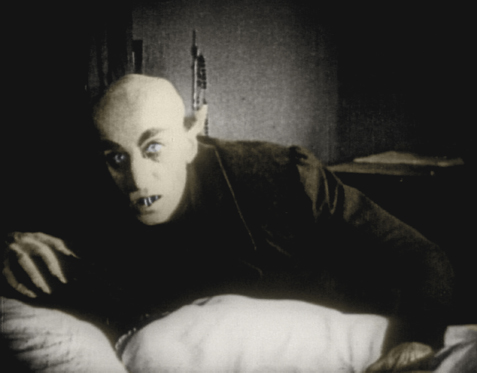
Behaviors we have come to regard as vampiric are inextricably linked to early cinematic technique. The supernatural powers of Count Orlok in Nosferatu (1922) were largely defined by the cinematic technology of the time.
Just as the powers of vampires changed with advances in film, some of these vampiric features will also be dispelled with the progression to digital.
Keller explains, “One of the things that used to be a big deal was that [vampires] couldn’t see themselves in a mirror, or on camera...because of the silver nitrate in the film, but now it’s digital. Digital cameras mean vampires can now be photographed, everybody can be seen.” The physical filmstrip is rarely used in contemporary filmmaking, therefore removing the fatal connection between sunlight and the vampire; modern vampires are able to walk around unscathed, even when exposed to daylight. The digital realm, therefore, has an equalizing effect—on both the undead and the alive.
The idea that the lives of the alive are more public or that people are more exposed to the world as a result of the digital age and the Internet, informs Keller’s work significantly. “30,000 people a year die [who have had a presence] on Facebook, and there’s very little you can do about those pages....There’s a way in which you’re not only immortal on the Internet but also you are now specifically undead. But your afterlife in the digital realm is mutable, it changes all the time. Other people continue to interact with you or some vestige of you.”
Technology has also affected the location of vampire narratives. Classic Victorian vampire stories take place in cities like London during the inception of the industrial age because, as Keller says, “Modernity calls the vampire to the metropolis. For the vampire, cities are an all-you-can-eat buffet.” But now, Keller notes, “The most popular vampire narratives of the moment seem to be taking place outside of cities and I think that has a lot to do with the fact that so many people have access to the Internet.” For example, Twilight is set in Forks, Washington, and “True Blood” takes place in Bon Temps, Louisiana—both small towns. However, because all the characters are connected to the rest of the world through the Internet, the need for a big city diminishes.
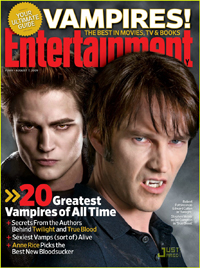
Robert Pattinson as Twilight’s Edward Cullen, left, and Stephen Moyer as “True Blood’s” Bill Compton made Entertainment Weekly’s 2009 list of top-ranking vampires.
Present-day vampire characters and depictions regularly rely on technology. Jessica, a character in “True Blood,” has her own blog where she keeps viewers up to date on her day-to-day life between episodes. Eric Northman, another “True Blood” character, participates in a Skype trial during an episode. As with Count Orlok in Nosferatu, certain vampiric qualities displayed in “True Blood,” such as vampire sex, can only be created using current cinematic technology. Keller notes that the producers of the show use a program called After Effects to generate high-speed vampire intimacy.
So, where is Keller’s research headed? “The claims that I can make now have to do with the 24/7 on the network thing. We have an afterlife. We are not entirely dead. We have to manage that afterlife even though we will not be here to see it. All of that brings us closer to the classical imagination of the vampire.” She continues to watch and listen to all things vampire. Since humans continue to be intrigued by vampires, and the digital world undeniably isn’t disappearing, surely vampire narratives will continue to morph in the coming years.
“Cinema showed us what the vampire could do,” Keller notes. Once at home in the world of classical cinema, the vampire is now a creature of the digital age.















